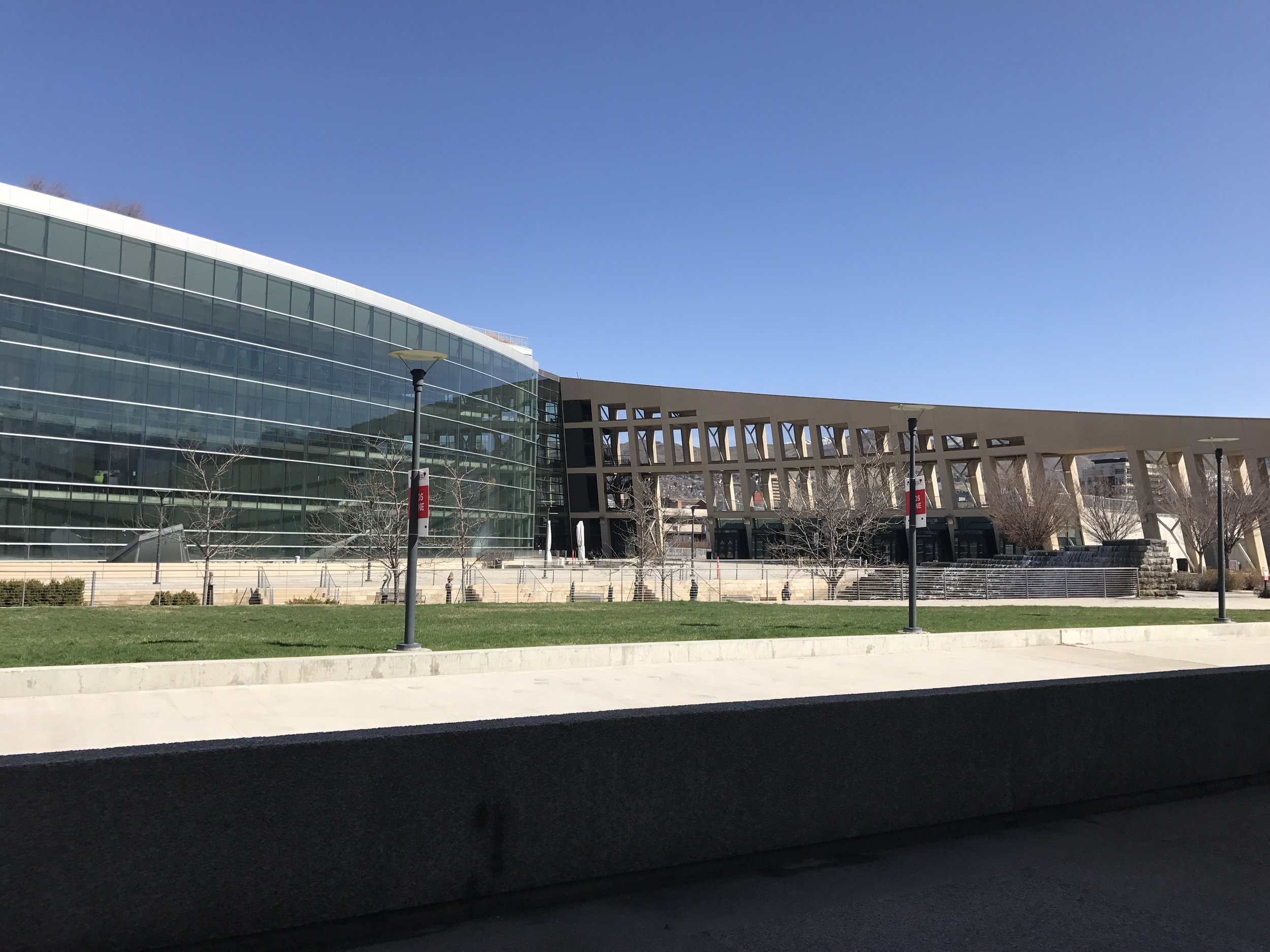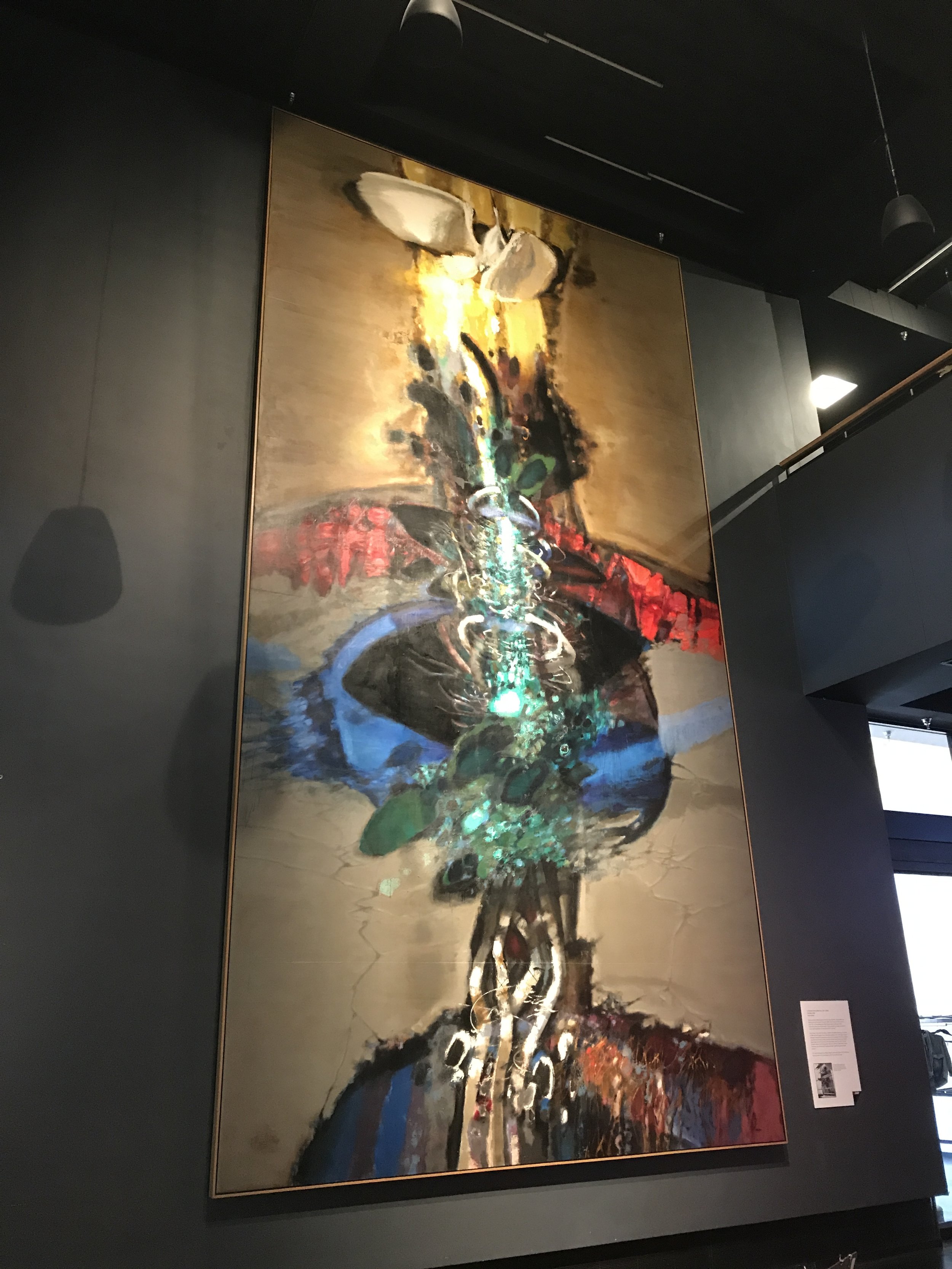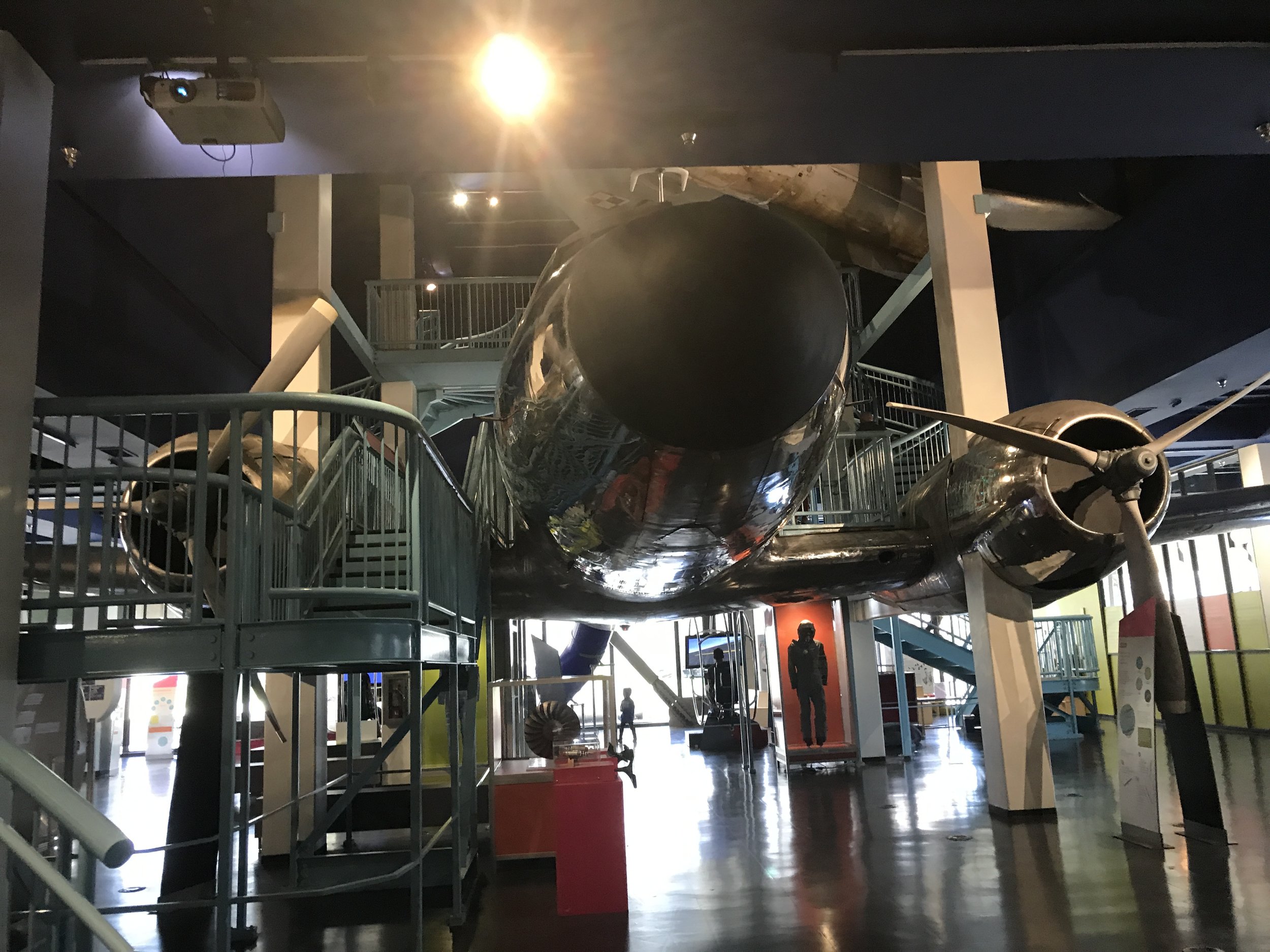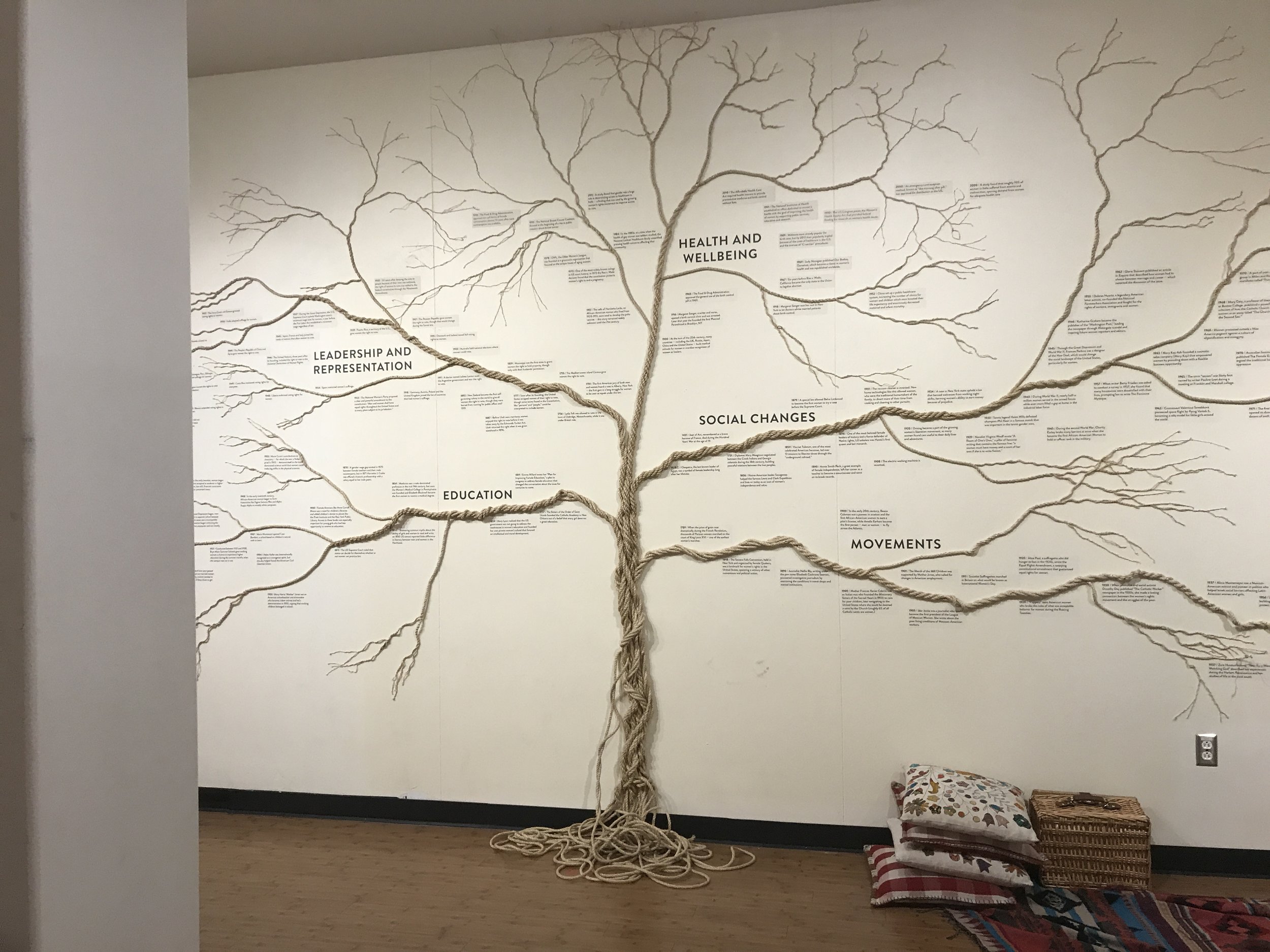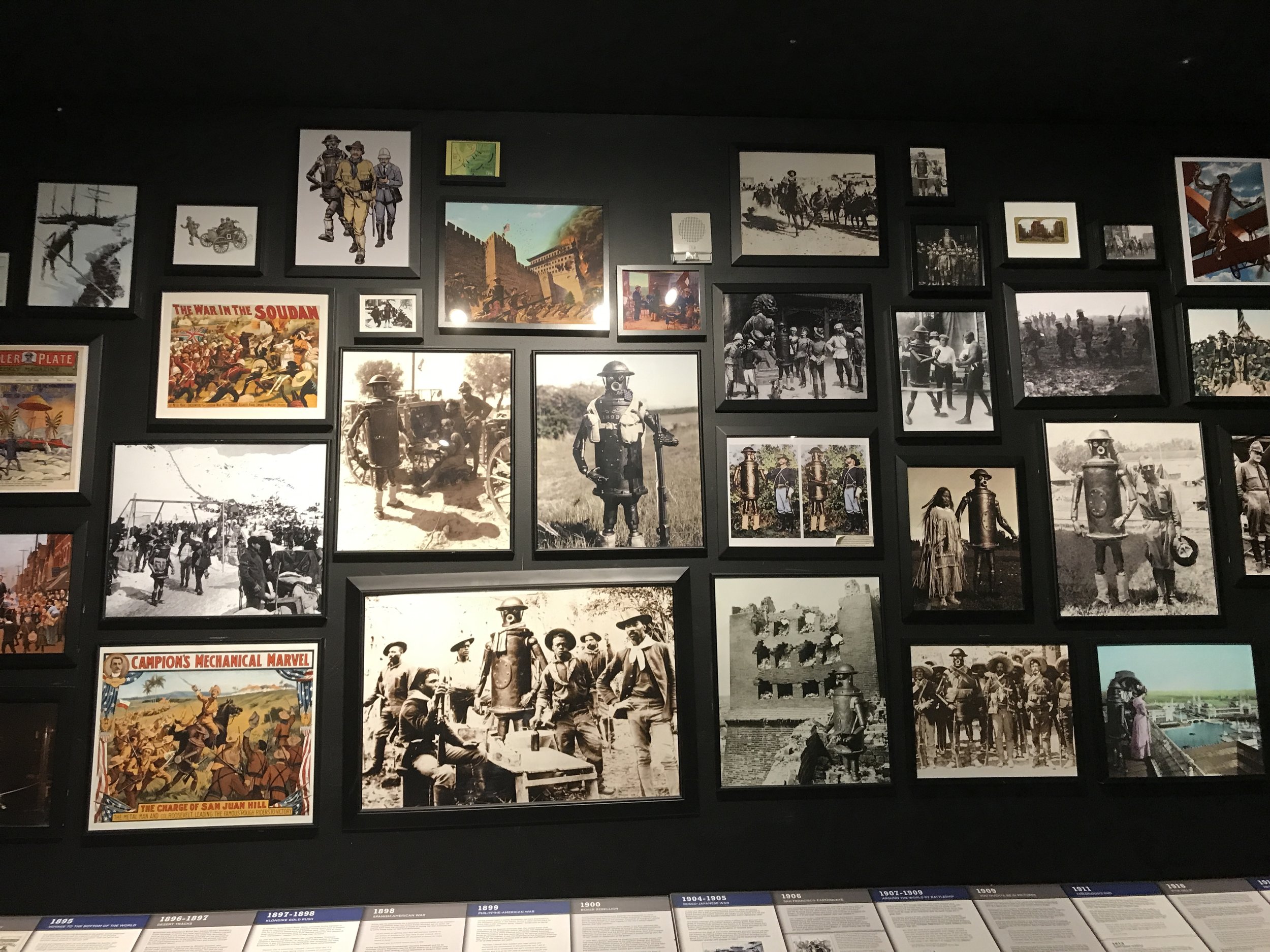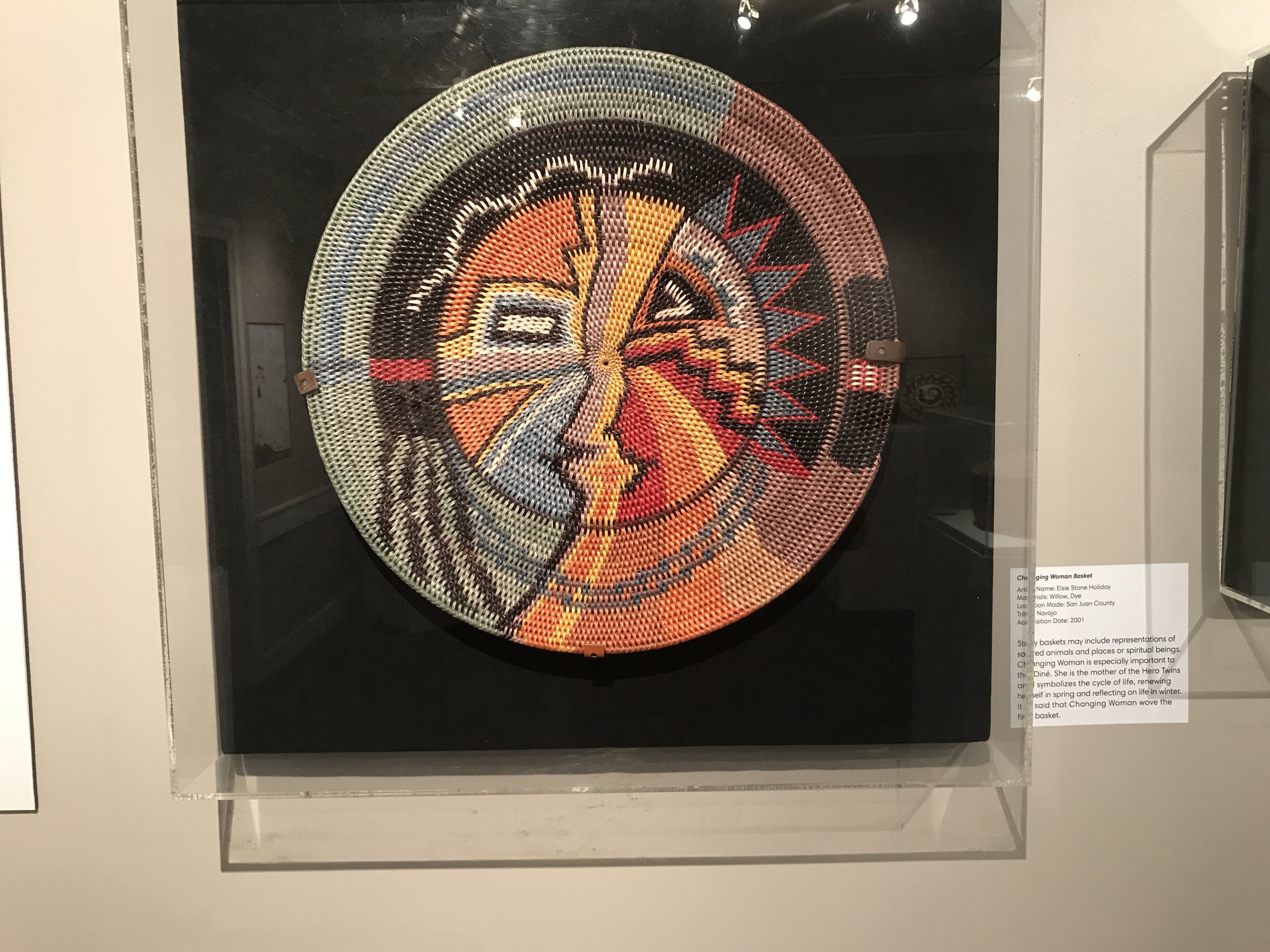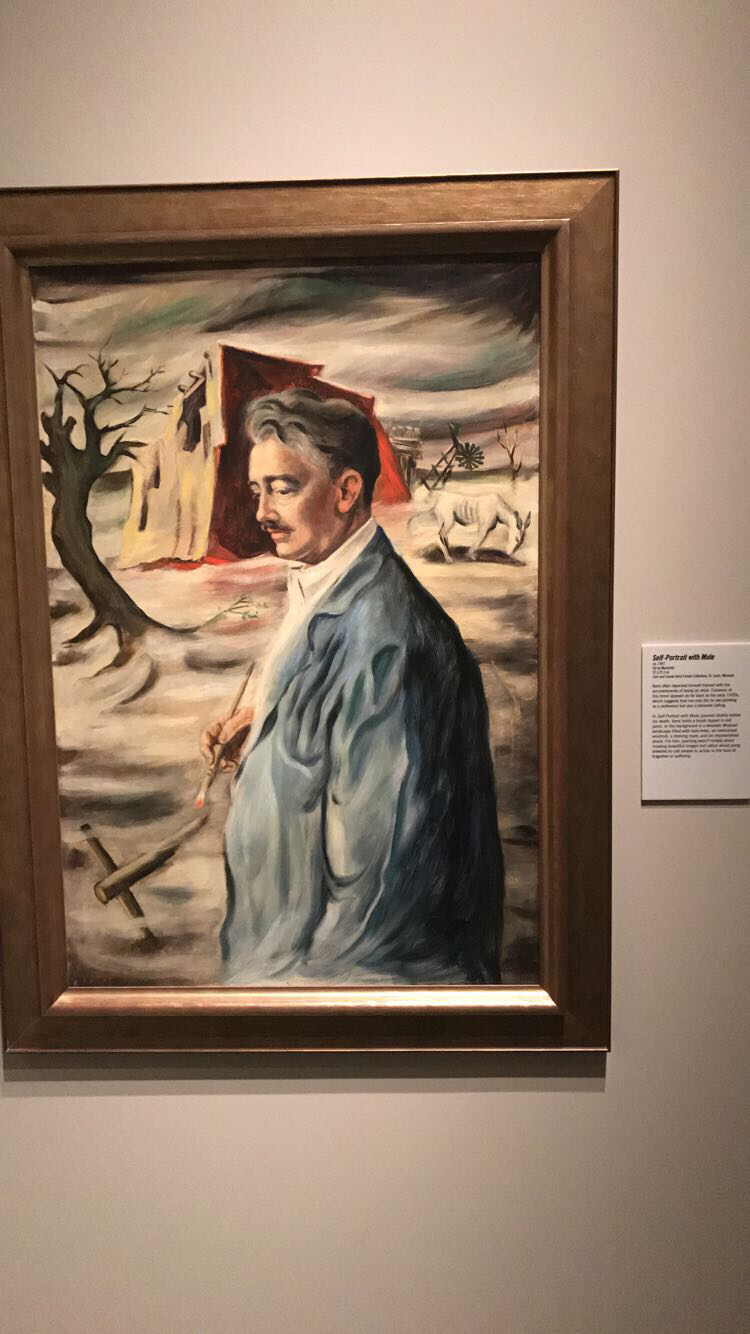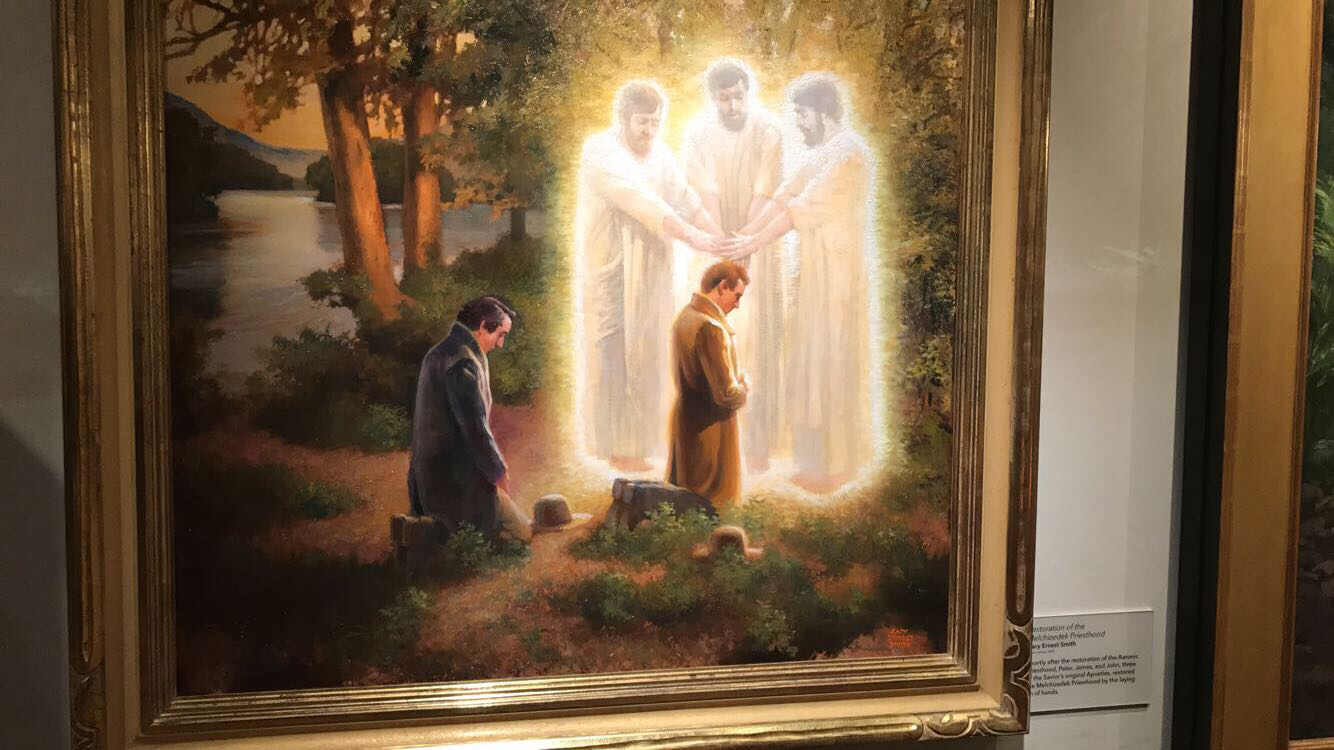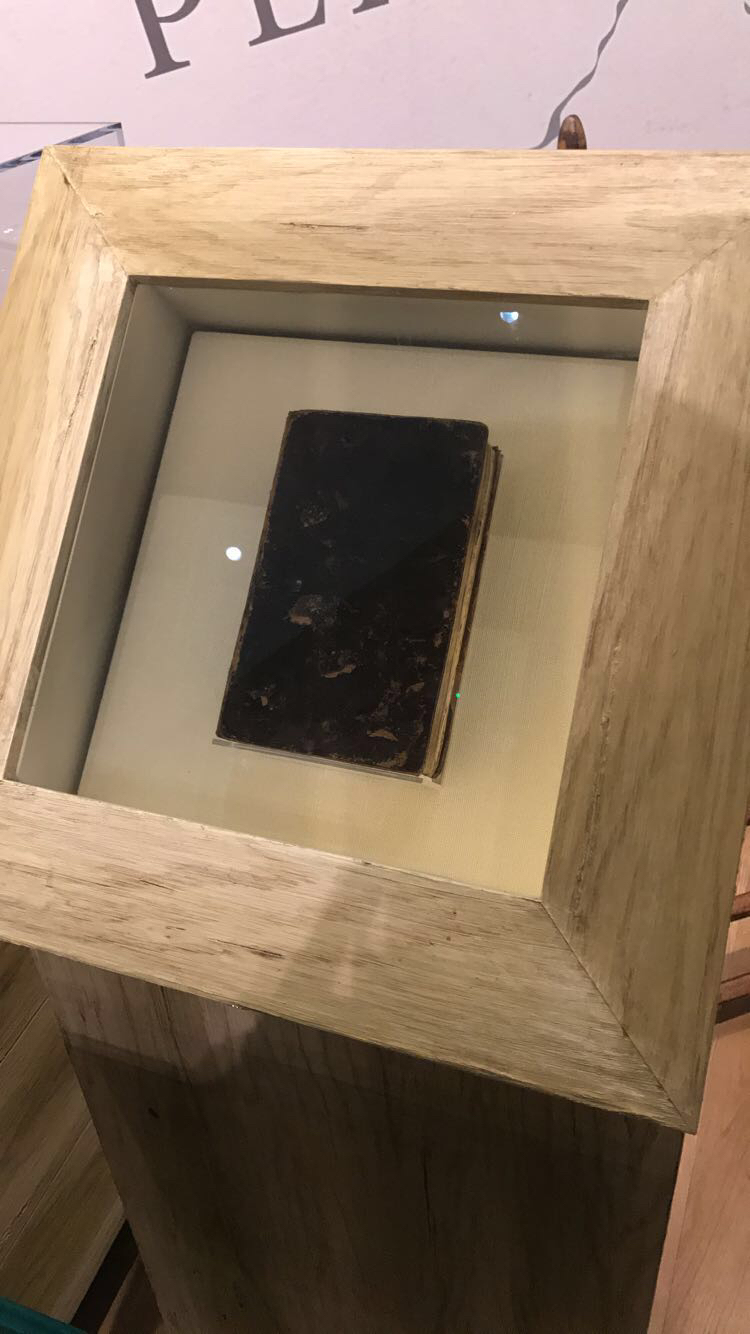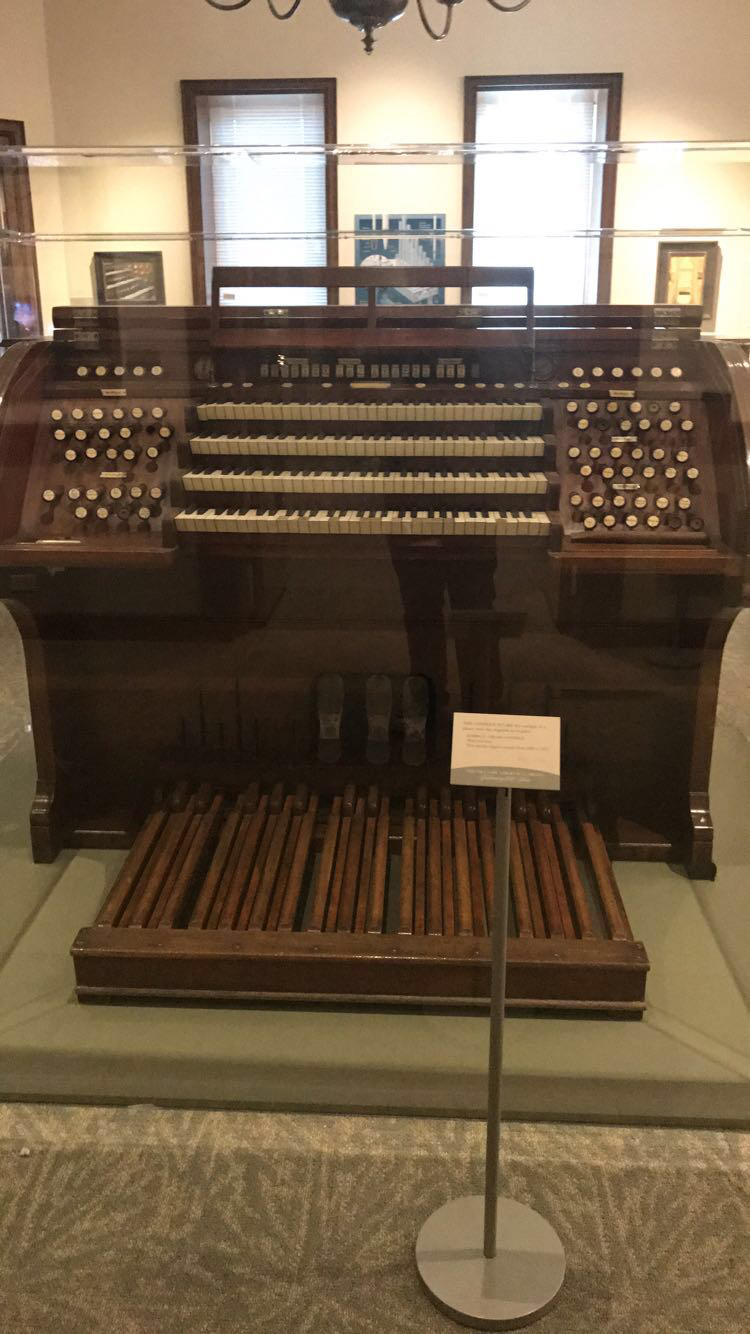UT Day 2 - Flying Machines, Folk Art, and Fantastic French Fries
Much like yesterday, today also started with a shocking surprise (an unintentional trend of my first days in Utah) as I awoke to what I thought was a baby crying only to discover that somehow in my tiredness the night before I walked right into the air bnb without noticing that there was a huge parrot in the living room. It was much more of a bloodcurdling bird wake up call than a rooster crowing.
After making peace with my new feathered friend, I set out to start my day the classic way with a nice big cup of ice coffee. I went to, Alchemy Coffee, which had really great coffee, friendly service, and a cool vibe with lots of skulls and weird art all over the place. I particularly enjoyed this very surreal dreamlike painting of a coffee hula girl on a remote and ominous island.
My first destination for the day was the Leonardo Museum, a museum dedicated art, science, and technology in the vein of Leonardo Da Vinci, Salt Lake City’s most famous resident naturally. The museum is located in what used to be the city’s public library, but just across the street is the new Public Library which I have to give a shout out to because it is one of the most stunning pieces of modern architecture I’ve seen in a while. The building has a sort of wedge like structure with a big curved glass wall complimented by a concrete spiral and a rooftop garden. It doesn’t really look like anywhere else I’ve ever seen, and I love that a city was willing to put that kind of money and creativity into a place for free books and education. I also read online that they have the largest collection of graphic novels of any public library which just makes me love the place even more.
And here’s a top down view because my photo can’t really do it justice:
When I was done admiring the library, I was happy to start diving into the Leonardo. Much like it’s namesake, it’s sort of all over the place with its interests combining lots of different facets of art and science and showing their individual merits as well as how the two interact and inform one another. That might sound sort of heady, but it was also geared towards families with lots of interactive and kid-friendly displays, because I think more than anything else the museum wanted to celebrate curiosity in all its forms. The first thing that jumps out at visitors when you walk in is a massive untitled painting by Douglas Snow. It was actually originally purchased in 1964 for the original museum, which explains it’s abstract expressionist tendencies. I watched a video of the artist talking about the piece, and he explained that he felt if people would be seeing the work in a public space on the regular, he wanted to give them a work that they wouldn’t quite get used to, that they could look at multiple times and always get something new out of. I’ll admit I thought it was kinda ugly when I first looked at but the more I started it, the more absorbing I found it. The one thing my photo really can’t capture though is the sheer scope of it, because it’s truly massive clocking in at 27X14 ft and I think just having to crane your neck to take it all in adds to the sense of wonder of the piece. The Leonardo decided to keep the mural in its same location to honor the legacy and history of the building, but also because it did really neatly fit into the themes of the museum as to make a work that monumental the artist had to do a lot of creative problem solving to give it the same sense of texture of smaller abstract pieces so in that way it does hit that intersection of artistic and technological ingenuity.
The first gallery I checked out was dedicated to Da Vinci’s lifelong passion for flight. It starts with an art installation called The Tunnel of Dreams, that features a cool blue tunnel mixing both imagery of constellations and schematic blueprints funneling down into a recreation of a 1960s living room and a family watching the moon landing. The use of inclined floors, gentle colors, and expanding tunnel create a neat dreamlike effect meant to show the circular progress of human innovation as one generation’s dreams become the technology of the next which inspires the dreams of the one to follow them. It was really beautiful. After the living room was a station for taking photos that had a similar theme, albeit less subtle, that superimposed a recreation of Da Vinci’s proposed flying machine over outlines of commercial planes, and futuristic supersonic jets.
After the artsy introduction, the rest of the exhibit was more focused on the history and science behind aviation. Many of these displays explaining different kinds of flight and the forces (such as thrust and lift) that make them possible were interactive which made all the science more tactile and easier to understand which went over particularly well with all the children running around me, and I saw a lot of kids excitingly running back into the exhibit to try everything again which made me smile thinking of all the times I dragged my mom back to the Boston Museum of Science. For the older crowd, there were some displays of different historical items like the first ever successful jetpack and posters featuring different experimental models of current aviation innovations. One corner also featured a cool community work-in-project of an airplane being built entirely from scratch with funds entirely through donations. It was very sweet to see a community banding together for a very literal flight of fancy. In terms of fun historical facts, I enjoyed learning that Da Vinci tested all of his flying machines in fields far away from other people because he figured that if anyone saw him running around flapping weird things strapped to his arms, people might have thought he was crazy. It probably didn’t hurt to hedge his bets. My personal favorite part of this exhibit though was a little movie theater set up in one corner with (naturally) old air plane seats set up as the different rows. The only movie they played was a sort of blooper reel of aviation history of all the hundreds of truly impressive and creative failed attempts at flying ranging from things that came pretty close to others that you feel must have been dreamt up by total maniacs. It was thoroughly entertaining and funny, but when the video ends with actual airplanes taking off, it’s oddly inspiring to see just how much work and failure and grit goes into making something so damn unlikely a reality.
The big set piece of the exhibit though was two actual planes that barely fit into the space, a massive C-131 that once belonged to the US Air Force and a smaller MIG-21 which holds the record of being the most produced jet engine model of all time. The larger plane was opened up for visitors to actually walk around in and either explore or just lounge on comfy beanbag chairs they had strewn about the cabin. You can probably guess which option I was more excited about.
Lastly they had a display of winners and finalists from a photography competition of all photos taken using flying drones. I’ll be honest, I’ve found the recent obsession with buying drones to be pretty silly, but seeing an unreal image like the one below, I don’t necessarily want one myself but I’m glad at least some people have this capacity now.
After the Flight Gallery, I went up a floor where the museum keeps a rotating exhibition related to some issue of Human Rights, and the current exhibition was a pretty great exhibition about the history of feminism and women’s rights around the world (the Da Vinci connections are usually more thematic than necessarily direct one to one correlations). The centerpiece here was a 40 foot long winding mural called Work In Progress developed by artist Jann Haworth as a way to both celebrate a small fraction of the thousands of women who have made momentous contributions to art, science, and/or social thought throughout history and to involve the community to make it a living breathing work that creates continuous engagement with their legacy. The piece consists of over 120 stenciled portraits of historical women drawn by over 150 community volunteers from around the country and then arranged by a collage artist named Liberty Blake. The effect is really dizzying and powerful with the portraits capturing both a wide diversity of notable women and an ever-changing array of artistic styles. It was beautiful to look at, and I liked the sort of scattershot nature of who’s placed next to whom because it makes your brain start making connections between women who you may never ordinarily think of in the same context like Ellen DeGeneres and Nefertiti.
The next room featured some more impressive art pieces but with a bit less obvious and more subversive ties to feminism. This room featured mostly abstract pieces of art that were made using traditionally feminine art and craft techniques such as knitting, crocheting, sewing, and even doily making as a way of showing how widely celebrated male abstract expressionist artists really adopted a lot of patterns and designs from feminine art traditions. When the men did it, they were called geniuses, but when hundreds of years of women did it, it wasn’t considered fine art so it was cool to see female artists reclaiming their own traditions, and I’ll be honest the more tactile abstractions were more interesting and novel to me than some of the more common paint based ones. The big centerpiece of this room was a big woven tree diagram making connections between different female-led social movements throughout history. It was really far reaching and sprawling and super powerful. Lastly there was a documentary by filmmaker Tiffany Shlain about feminism through the years. I didn’t watch a whole ton of it, because I had to make it to all the other places I wanted to see today and it was actually feature length.
The next floor up was all dedicated ideas of innovation and perception, where Da Vinci arguably made his most important artistic and scientific progress. The first exhibit on this floor was a really fun and funny one that feels alarmingly relevant to today’s age of “fake news” accusations. It was called Fantastic Forgeries, and featured a series of very elaborate hoaxes. One wall was all fake inventions by the fake inventor Henry Hokes, many of which were elaborate pun or impossible objects such as pointless nails, a suspension of disbelief, or dehydrated water. The legacy of Henry Hokes was documented by his fake biographer Franklin Fishfarte in an ornate bound coffee table book available for visitors’ perusals. The other half of the forgeries exhibit was all about the inventor Archibald Campion and his robot sidekick Boilerplate. Together the two companions traveled the world, aided in various wars, gave scientific speeches, and even starred in a few silent films. The story of their travels was relayed with a wonderful series of doctored photographs and vintage posters that inserted the silly little robot and his human inventor Forrest Gump style into various moments from history. The attention to detail in making giving these goofy inventions authenticity and backstory was really pretty impressive, and while none of it really holds up believability given a base amount of scrutiny, sometimes the forgery is a piece of art in its own right.
The next exhibit was called City Blocks and was all about city planning, taking the concept of a city block quite literally by recreating notable buildings from SLC in Lego form. I grew up with legos, but never had much skill for real design with them so seeing what some people are able to do with those little blocks is truly incredible, right down to capturing the texture of rolling hills. They even got that cool looking modern library!
The real test of what I thought was possible with Legos came after all the city blocks with a gallery of pop art portraits by the artist Jen Smart in which she creates the likes of Robert Downey Jr. and Lady Gaga entirely in brick, blowing my goddang mind in the process.
The mind bending continued into the next gallery which was all about optical illusions and tricks of perception. This was geared toward a bit of a younger crowd, but I’m a sucker for optical illusions and I actually saw a cool one I’d never seen before that really knocked my socks off. The museum had a series of lithographs that when laid flat looked like relatively normal landscapes but when viewed in a concave mirror became a portrait of a man. I can’t draw either particularly well so being able to encode both in the same picture at the same time is totally beyond me.
The last exhibit was all about innovation and inventions from Utah residents, with particular emphasis on works by female inventors and innovators to tie in nicely with the second floor gallery. These weren’t all invented by women but a list of notable inventions from the Beehive state include frisbees, Atari, and possibly the television depending on who you ask. My personal favorite though, was a life-sized lego sculpture of Wonder Woman made entirely out of legos.
Lastly there was one more art piece that actually sprawled and permeated all throughout the museum called the Hylozolic Veil by Phillip Beesley. This dynamic, immersive piece combined artistic design with a variety of scientific disciplines including chemistry, computer science, and physic. The glass and plastic meshwork of the sculpture is equipped with different kinetic parts, light sensitive sensors, and even small glass pods filled with chemicals that help purify the air so that it is always moving and changing based on all kinds of inputs from the environment. It’s absolutely bananas that so much technology like this even exists let alone is able to be put all together for an artistic experience. It was really dazzling. Though looking up at it from the escalator did feel a bit like entering the biggest spiderweb you’ve ever seen.
After all that art and science, I had worked up a mighty appetite so I set sail for a place that was recommended by several of my college band friends who had gone to SLC to play at NCAAs the year before my freshman year. Bruges Waffles and Frites is a Belgian style purveyor of fine french fries, waffles, and sandwiches. It was truly heavenly and I had to resist every urge not to get every sweet and savory thing on the menu. I ended up going the frites route with their specialty Machine Gun sandwich which featured perfectly toasted french bread stuffed with fries and housemade lamb sausages drizzled with a house Andalouse sauce (I swear there are sausages in that photo underneath all the fries). It was delicious, but I’m also pretty sure it single handedly shaved five years off of my life. Worth it.
Up next, I decided to exorcise some of my french fry related demons by enjoying the beautiful weather and taking a walk in Liberty Park, a lovely 80-acre park in the middle of SLC. At one end of the park was the historic Chase home, once belonging to Brigham Young’s buddy and mill magnate Isaac Chase. Standing all by itself in the greenery, the old mansion does really take on a very stately look.
The Chase House is still open to the public and now houses the Utah Museum of Folk Arts, a three story of collection of small galleries dedicated to the self-taught and indigenous artists of the state. It wasn’t the largest collection in the world, but packed plenty of quality where it lacked in quantity. Pieces included elaborate wooden sculptures, beadwork, and ceramics by Native Americans from the regions, metal work by local craftmen and artisans, and even a decent smattering of folk art from around the world acquired on various Mormon mission trips including one impressive piece of silver work from a trip to Mexico (top center)
My favorite pieces skewed a bit more contemporary including: a beautiful and gruesome hand carved retablo relaying the tale of several murdered journalists in South America; an incredibly intricate cast iron vase of roses; a very Gene Simmons-esque Polynesian wood carving; and some classic southwestern Kachina figures that I never get tired of seeing.
After folking it up, I climbed a very gentle hill and thoroughly out of breath I marveled at the lush scenery of the park with clear blue waters and white capped mountains in the distance. It was really something.
I continued to walk around the park, and one of their other notable places was the Tracy Aviary, a small museum and wildlife center containing over 400 birds of over 120 species. It looked very immersive and impressive, but I wasn’t feeling like spending any extra money to go in so I just enjoyed gawking at the birds I could see from the outside, including this very ugly boy of a vulture.
After my nature intake, I decided to get a much overdue hair cut. I was pleasantly surprised to learn that Salt Lake City is actually home to two very prominent barber schools, so many of the local barbershops are staffed with either really highly trained barbers or really good barbers in training so I just sort of stumbled into one of the best haircuts I’ve ever had. I ended up going to a place called the Salt Lake Barber Company. Everyone there was incredibly warm and friendly, and it was one of the rare times in my life where barbershop conversation flowed totally comfortably and naturally (this is nothing against any barbers I’ve had, I know I’m the awkward one in this dynamic 9 times out of 10) and my barber not only gave me a great cut but also some good suggestions of where to get really strong beer in a relatively dry state. I really enjoyed our conversation, and by the end he had me looking like a nice clean cut Mormon boy (as someone who happens to have blonde hair and blue eyes, the amount to which I fit in here was deeply unnerving).
After my haircut, I proved I was not a good Mormon boy by immediately getting more coffee to fend off my encroaching sleepiness. I went to nearby Blue Copper Coffee Room, a very sleek industrial coffee shop that whips up a mean a mean cold brew to get you through your mid-afternoon slump.
To make up for the caffeine indulgence, I decided to be a bit more fair to the Latter Day Saints and visit the free Church Museum to really see what they were all about. I’ll be honest most of my knowledge of Mormonism comes from South Park and the Book of Mormon, so while I was sure the museum might be biased in the opposite direction of Matt and Trey’s teasing I figured between the two I’d get a pretty fair picture of Utah’s most famous residents. I wasn’t converted, but I did actually enjoy myself quite a bit because beyond the dogma there was a really good bit of both art and American history all wrapped up in the harrowing trek the faithful made from Upstate New York to Utah. The big take away for me is that I really don’t feel like Mormonism is all that different from any other religion, it’s just newer so the growing pains that might have seemed strange to a lot of people are actually what just about every new religion probably looked like to the outside world when it started. In actuality, I sort of ended up having to give them a lot of credit because while the faith is still a work in progress they were actually a lot quicker to just excise more problematic practices from their dogma than a lot of other mainstream religion, and modern Mormonism has come a long in a very short amount of time in becoming more accepting than they started out (and I did some outside research on this because I figured the museum would give a rosier picture of things, but while I don’t think any religion is perfect i was happy to learn that this is indeed true). Regardless of how you feel about the religion though, I think the one thing basically everyone could enjoy in the museum was some really astounding art throughout all the exhibits. Because Mormonism started in America, Mormon art through the years actually ended up being a pretty neat portrait of different American art trends from the 19th century onward with romantic religious portraits leading into sort of impressionist religious gatherings to more modernist and expressionist prints and paintings. And because the workss were not only just about Mormon tenets but also either owned by church presidents or made by LDS artists, there was actually a decent smattering of different themes to keep things from getting entirely one note. A personal highlight for me was gorgeous stain glass window celebrating the beehives that made Utah famous.
My absolute favorite piece of art though was this painting right here that unintentionally made young Joseph Smith look alarmingly like Ringo Starr. I really wanted to be a respectful guest, but that resemblance is uncanny and I could not stop from cracking up at picturing all the religious dialog in a Liverpool accent.
Despite all the great art, the museum first and foremost was about the history of the Church. In this regards, Mormonism really benefits from being such a relatively recent belief structure because so much of that history is actually documented and well maintained. They actually had a printing press and bible that had belonged to Joseph Smith as well as letters from both him and Brigham Young which were pretty neat historical document regardless of faith. Some of the more mystical elements of the religion like the golden plates and seeing stones Smith was given by angels were recreations as the “originals” were never given to the public.
The most interesting part of Church history for me was the history of relocations, persecutions, and skirmishes that occurred between early LDS members and their neighbors. Not all the relocations were forced through violence as some were for financial reasons such as when Joseph Smith’s bank failed. I really did get the impression that Joseph Smith genuinely cared for his flock but there certainly was a financial element to becoming the leader of the church (not to mention the whole multiple wives thing but we’ll get to that) and based on the history he was often a better orator than businessman. The thing that has always baffled me in history classes though was just why the reactions were so frequently violent against Mormons by the locals wherever they landed. In answering this question, I felt like the museum was generally pretty fair in explaining both sides of the issue. For sure some of the antagonism was purely discrimination at a new faith, but what I learned here that honestly makes a lot more sense was that most of it was politically motivated. Whenever Mormons moved into a town, they tended to all vote unanimously so when such a large group of like minded-voters moved anywhere they could effectively take over a town council if they chose to and this scared the hell of locals much more than differing religious ideologies, particularly in pro-slave states (Mormons were very anti-slavery which is great, though up until the 80s other aspects of their theories on race weren’t super great) who were already dealing with a lot of non-Mormon abolitionists leading up to the Civil War. It was usually easier to run them out of town than open up a deep and probing dialog, so violence frequently erupted which created a sort of vicious cycle where Mormons fearing very real violence would create armed militias which would then further scare locals wherever they moved creating more anti-Mormon violence. It was rough, and the craziest thing I learned (besides the belief that Adam and Eve ending up in Missouri) was that many states didn’t formally get rid of anti-Mormon Laws until 1976! It’s wild thinking that they had to put up with such fear of violence for so long, but they were not totally blameless in all instances which I was surprised to learn because I just sort of assumed Mormons, like Quakers, were staunchly non-violent but in the early days (particularly under Brigham Young, who unlike Joseph Smith seems like a legitimate crazy person who advocated for human sacrifice, no shit) Mormon militias did fully try to violently overthrow anti-Mormon newspapers and similar things, and although this may not have happened without previous anti-Mormon attacks, it wasn’t exactly something that convinced people that they’d be good neighbors. In regards to polygamy, which is probably the thing that most frequently gets negatively associated with Mormonism in popular culture, it was initially an optional practice as proscribed by Joseph Smith, and it wasn’t strongly encouraged until (straight up crazy person) Brigham Young took over the church. It certainly stoke non-Mormon fears and paranoias about the religion, but it has generally fallen out of favor with the mainstream branch of the church, only really being continually practiced by fringe sects.
The wildest story that I’d never heard before was a straight up Old West Showdown that was the death of Joseph Smith. Smith and his brother Hyrum were arrested at one point after he was accused of inciting a riot when some other Mormon leaders got mad him for excommunicating them after they didn’t enjoy his proposal to marry their wives (maybe not Joseph’s most sympathetic move). While the Smith brothers were locked up in Carthage jail, a mob of anti-Mormon agitators stormed the jail trying to kill the church leaders. Hyrum was killed early on trying to block the doorway to the jail cell, but Joseph fought off the armed mob for as long as he could with a pistol his friend had smuggled him into jail before he too was overwhelmed by the mob and killed. That was just way more action packed than I ever expected church history to get.
Lastly was an exhibit about tall the former presidents of the Mormon Church, and this featured some cool historical documents. I particularly enjoyed some gifts from Hawaii from the first Mormon president to visit there (apparently Hawaii has one of the largest Mormon populations of any non-Utah states which is fascinating) though much more interesting than any one president was the beautiful old grand organ that has served the church for well over 100 years and has just recently been refurbished to its former glory.
After all that piety, I decided to get back to my sinful ways and go to a local brewery called Epic Brewing Co. which had come highly recommended by my barber. It turns out that while Utah may have very strict laws about the allowed alcohol content of their imported brews, there are no such regulations on the local stuff so to compensate many local breweries, like Epic, specialize in high alcohol content beer. Because it was just about all above 6% abv, I only got a small flight of three samples but I really loved everything I had. As another funny quirk of UT’s vice laws, they weren’t technically a bar but in fact registered as a restaurant so in order to drink there you also had to order food, so I had a pretty nice bowl of chowdah. It didn’t fully live up to my New England standards, but it certainly did an admirable job trying. The beers on the other hand really blew me away. I tried a really smooth easy drinking beer called the Mid Mountain Mild, a powerful double brewed dark lager called the Double Skull doppelbock, and their crowning achievement, the Big Bad Baptista, an amazing bit of handiwork a double barrel aged imperial stout also aged with Mexican coffee clocking in at over 10% abv and packing loads of flavors including touches of cinnamon, vanilla, chocolate, coffee, and whiskey. It was powerful bouquet, and if you can handle it all I couldn’t recommend it more.
Thankfully given how strong everything was the open mic for the night was within walking distance of the brewery so walk there I did! The mic was tucked in the corner of a nice pizzeria called Wild Pepper Pizza. Going in I was a little bit skeptical of a pizzeria as a performance venue, but when I got there a decent sized group of comedians had already gathered assuaging my fears. It actually turned out to be a really solid venue with a good crowd of comics and non-comics there to see the show and support their friends as well as a solid contingent of people waiting on delivery orders who sort of got sucked in by the jokes. Before the show all the comics were incredibly welcoming, inviting me to sit at their table and sharing jokes, stories, and advice warmly and openly. The mic the night before had been nice but pretty sparsely attended so it felt nice to be really surrounded by comics again, and I think I was able to get a better feel for the scene more generally speaking.
Luckily for the audience who just came to hear jokes, the comedians were as funny as they were friendly (which I mean as a compliment in both regards lest anyone think I’m being a wise ass). I think overall my favorite comic of the night was the host Steven Ethington who had a really great absurdist flair for concise tightly written jokes that frequently caught you off guard in the best of ways, my favorite being “My parents weren’t big on child safety. They strapped me in my car seat… but then they tried to mail it back”
My favorite single joke of the night came from a comedian who just went by Taurus (sp?): “I don’t get people who get mad whenever comics talk about sex on stage. I don’t understnad the logic of ‘Hey, he’s talking about that thing I like. I hate that!’”
Other Highlights:
Colin Williams: I think Mormons have two many kids. Like in my family if two kids died, you’d still have 81% of your kids. That’s a B minus in kids, which feels a bit high”
Adam Conrad- Can I even call this pre-cum anymore? it’s been coming out for hours (it’s gross but he really sold the idea of it being a genuine innocent inquiry which cracked me up)
Matt Foster- ( he did a long, really almost literary rant about sexism being ridiculous, but it’s not so much the rant itself but the turns of phrase he would pull that kept you on your feet i.e. talking about dudes being squeamish about periods by referring to tampons as “old time pussy corks”. I don’t think James Joyce could have done it better and lord knows he tried)
My own set went over pretty well and my place in the lineup time out well with me recovering from the pre-show brewery trip. I was towards the end of the lineup, but I still had a nice audience and I feel like I made a good impression so all in all it felt like a bit more of an official welcoming to the SLC comedy scene.
After the mic, I went to get a late night coffee boost at a nice place called Coffee Garden which was thankfully open past 9pm. I had some fun joking around with the (probably slightly sleep-deprived) baristas and then I was able to go home and enjoy my coffee with a beautiful chocolate dipped waffle that I had purchased with my lunch at Bruges and somehow managed to have the will power to resist until now. It was the perfect way to end the day.
Favorite Random Sightings: Cash for Kid Stuff!'; Babe Guru; “Come in, you will be pleasantly surprised!” (amusingly realistic billboard); Cake Hair (no clue)
Regional Observations: Most of the streets in SLC have numbers instead of more verbose names which as a newcomer I found very it very confusing especially since some streets had the same number but were instead differentiated by if they were going east or west.
Albums Listened To: Shootout at the Magic Factory by Traffic (a weird vaguely jammy album that held up way better than I expected); Show Me How You Want It To Be by SLOTHRUST (a very fun covers album); Show Time by Ry Cooder (an uneven but lovable live album)
People’s Favorite Jokes:
I had this awful roommate who never paid for anything, didn’t cook, or help around the house or anything. And when I went to kick him out, my wife said, “You can’t do that he’s your three year old son!’
(when asked for a joke the guy at the cash register just launched into a Trump Impression and said:) I went into Russian and thought I was gonna get a peanut butter sandwich okay, but instead of a pbj I got a pee pee bj
What did the sick chickpea say to the other chickpeaI? I falafel (feel awful)
Songs of the Day:
Little Stevie Winwood is only a year older than me in this clip which is humbling
so much funkier than the original
great song, associated with a lot of fond memories playing music with my dad. Plus where else are you gonna see an electric mandolin soul solo



